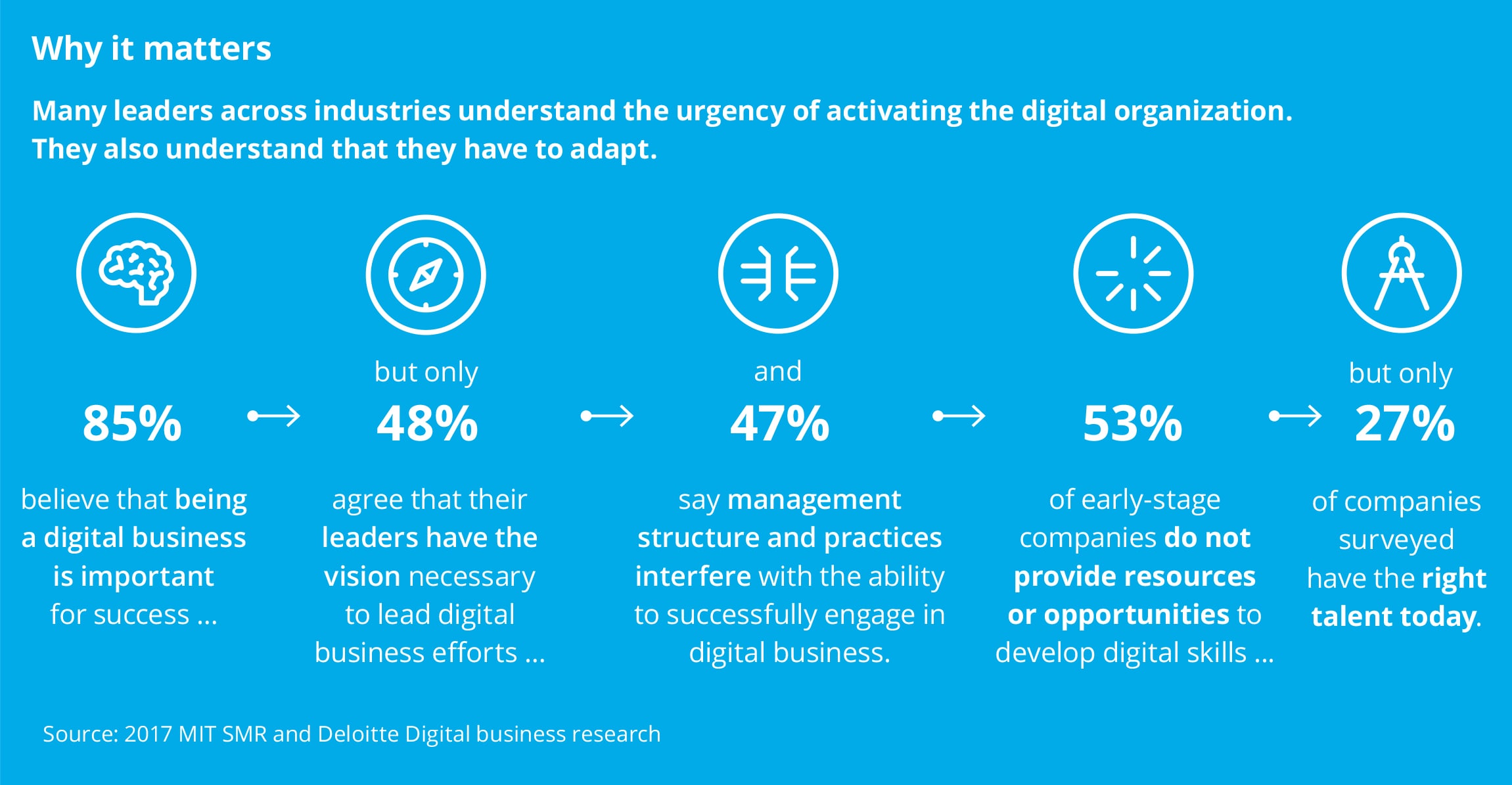Activating the digital enterprise has been saved

Perspectives
Activating the digital enterprise
Most leaders understand the urgency of activating the digital enterprise—85 percent believe being digital is important for success, in fact, according to Deloitte and MIT Sloan Management Review research
Most leaders understand the urgency of activating the digital organization—85 percent believe being digital is important for success, in fact, according to Deloitte and MIT Sloan Management Review research.
Explore content
- Understanding your digital DNA
- Activation drivers
- Digital organization principles
- Taking time to look at the numbers
- Get in touch
Understanding your digital DNA
When it comes to digital enablement, the days of incremental improvements are over. It's time to do something big—something more than moving systems to the cloud or adopting tools that let employees work when, where, and how they want to.
Activating the digital enterprise: A sink-or-swim moment for today's enterprise brings together insights from Deloitte’s research with MIT Sloan Management Review, as well as our work with clients across industries to understand the role of human resources (HR) in digital transformation. We have identified 23 traits that comprise an organization’s “digital DNA”—the qualities that digitally mature organizations share.
These digital DNA traits include an organization's ability to be intentionally collaborative, continuously innovate, "democratize" information, and operate with morphing team structures—to name a few. Understanding your digital DNA is essential to digital enablement and becoming a truly digital organization—and it's just one of several drivers that can help you accelerate your activation.

Activation drivers
Work reimagined
Reimagine what work will look like in the future and how it will fundamentally change as advanced technologies are incorporated. This entails redesigning work activities and processes to determine the best combinations of automation (e.g., robotics, cognitive) and human skills. High-volume, data-intensive, and repetitive tasks, as well as those that are physically dangerous, transition away from humans. Humans are freed up to focus on value add/strategic activities and those that provide better connections to customers, using character traits that automation is unable to match, such as empathy.
Network + leadership
Drive work through network-based teams that are cross-functional and agile with limited hierarchy. Doing so will require different leadership skills. What makes a leader “great” remains unchanged. A great leader, for example, knows that strong influence is imperative. Before, a leader typically used influence to persuade stakeholders to support initiatives or ideas. In the new digital context, a great leader will need to persuade skeptics of ideas that are unproven and that carry new risks.
Open talent workforce
Driving the future of work means introducing new talent categories in a more open talent economy. The vision includes salaried, “gig,” and ecosystem partners working together seamlessly. It also requires new ways of looking at workforce sourcing, performance, engagement, and rewards. Organizations should understand which skills to build, buy, or rent. And they should drive digital learning experiences that help build workers’ capabilities and allow them to develop along a 21st century career path.
Connected experience
Understand how you can drive a Simply Irresistible™ experience for the workforce that combines virtual and physical workspaces as well as digital tools that can drive productivity and deliver a consumer-grade experience for all workers.
Putting these drivers to work and enabling the new digital organization requires a high-impact HR partnership and a marketing approach for managing the evolution. To do that, organizations should have two things:
Digital HR
HR should drive your evolution and help the business define each component of the digital organization. HR also should be a “digital first” business that shapes the consumer-grade experiences and cultural behaviors that will help the organization thrive.
Digital enablement
Your organization should embrace a design thinking approach, with the customer (i.e., the worker and your leaders) at the center of the design. As part of enablement, you should take a marketing approach to understand how to guide your evolution, using analytics to determine the best way to help your workers develop, produce, and evolve. Accelerate business with an insight-driven approach—one that embraces iteration and helps you navigate human factors along the way.

What does it mean to be digital?
Digital organization key principles
Additionally, the three principles underlying the truly digital organization include:
- Digital at the core. They are redefining the business and make digital more than just talk. Digital processes, digital engagement, and digital strategy pervade every aspect of their operations. These organizations recognize that being digital involves far more than new technology and social media. They understand that digital success relies ultimately on how they organize, operate, and behave.
- Developing an enabling environment and culture. They intentionally cultivate their cultures, actively develop talent, and organize for digital maturity. This includes a workforce sourcing strategy that delivers the future of work and blends together on- and off-balance-sheet workers with cognitive technologies to reimagine the way work is performed. They create consumer-grade experiences for the workforce and give workers digital tools that help them manage time effectively and intentionally collaborate across geographies. They develop the skills of the workforce in a continuous learning environment, reinforce digital concepts at every opportunity, and encourage workers to think digital.
- Taking action, not just promoting a vision. They build commitment and digital-ready leaders that can actively help weave digital capabilities into the fabric of the enterprise—working across departments and functions to make sure that smart ideas and tools aren’t limited to one corner of the organization. They guard against simply throwing more technology at things. Instead, they strategize and think ahead, focused on enterprise growth in all its forms, and they commit the right level of resources to fund their evolution.




